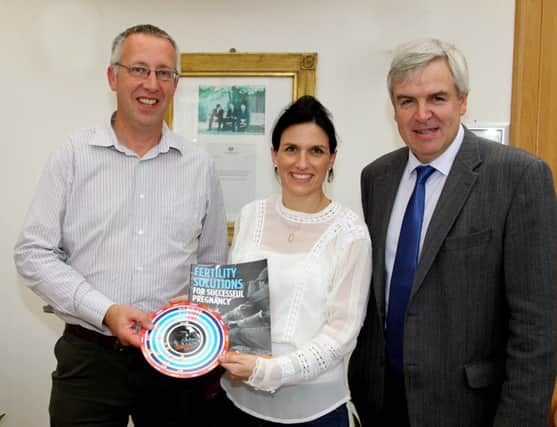Veterinary surgeons get the facts on breeding protocols


Increased pressures for time and shortage of labour on many units as well as shorter or less intense expression of heat by cows have all added to the challenges of heat detection.
Some problems with heat detection such as insufficient time and inaccurate heat detection can be partially overcome by using heat detection aids. Tail paint, pressure detectors, a vasectomised bull, milk progesterone testing, conductivity monitors, and activity meters can all help with heat detection.
Advertisement
Hide AdAdvertisement
Hide AdBreeding protocols are becoming more popular in cattle fertility improvement programmes and veterinary surgeons are getting fully involved with farmers in developing these programmes.
For this reason Zoetis recently organised a meeting for veterinary surgeons and invited Professor Mark Crowe, Professor of Animal Husbandry and Reproduction in the School of Veterinary Medicine in UCD to outline the various breeding protocols and their role in the farming enterprise.
Firstly the use of breeding protocols in cattle helps to minimise the problem of poor heat detection and allows the use of AI on heifers or cows in the dairy herd. They can also help to tighten the breeding season leading to more compact calving.
In order to maximise the success of a synchronised AI programme, nutritional management needs to ensure that body condition scores (BCS) are averaging 2.75 - 3 at calving and that cows or heifers lose less than 0.5 BCS units to service. Farmers should encourage dry matter intake in the early postpartum period to sustain this.
Advertisement
Hide AdAdvertisement
Hide AdMark outlined the use of PGF2α (e.g. Prellim®) for oestrous synchronisation in cattle, pointing out that it has a luteolytic effect (demises the corpus luteum) but has no effect on the follicles. Cows must be cyclic and have a corpus luteum present for PGF2α to work and it is only effective in the luteal phase (day five to 16 of the cycle). It is best used with observed heat, but can also be used with Fixed Time AI (FTAI) when two injections are given 11 days apart and heifers are AI’d twice at 72 and 96 hours.
The main uses for PGF2α are in replacement heifers and dairy cows from day six of the cycle onwards. It can also be used in seasonal calving herds two days before the start of the breeding season to increase an early submission rate. Other uses include individual cows with a corpus luteum or uterine infection and in conjunction with progesterone synchronisation regimes.
Mark then went on to describe the OvsynchR protocol in which the follicular wave is synchronised with GnRH (e.g.Acegon®) before the use of PGF2α (given 7 days after GnRH). This protocol is used a lot in the United States for Fixed Time AI in large herds without heat detection to control the time of ovulation in cyclic cattle. Conception rates using the Ovsynch protocol are averaging around 30%.
This protocol can be very effective if the cow has a healthy dominant follicle (min. 9mm in size) which responds to the first GnRH injection. If there is no response to the first GnRH then some cows will be back in heat before day seven and FTAI will be unsuccessful.
Advertisement
Hide AdAdvertisement
Hide AdA second GnRH is then given 48 hours after the injection of PGF2α to control the time of ovulation, followed by FTAI 16-20 hours later. The Ovsynch protocol should be used in dairy cows in herds with at least 50% cows cycling and organization is good enough to ensure timely application of all injections to the treated animals.
Ovsynch is shown to have very clear limitations:
l It does not really work in animals in deep anoestrus (dairy cows in deep negative energy balance (NEB)).
l It gives poor results in heifers.
l The timing of injections is really important so compliance has to be really good.
A third option is the use of a vaginal progesterone delivery system (e.g.CIDR®) in conjunction with PGF2a (e.g.Prellim®) to control oestrus. Historically progesterone treatments were administered for 18 to 21 days. Whilst this resulted in good control of oestrus, fertility was very poor as the extended treatment resulted in an ‘aged’ dominant follicle at the time of AI. Today’s recommendations are that a short duration of progesterone treatment is key – seven-nine days.
Advertisement
Hide AdAdvertisement
Hide AdInjection of PGF2a is given one day before the end of treatment and this affects the onset of oestrus. GnRH (Acegon®) is ideally used at insertion of the progesterone device in cyclic cows and heifers, which will ovulate the dominant follicle if it is present. This will be followed by the emergence of a new follicular wave one to two days later. GnRH can be used again prior to AI to synchronise ovulation.
A large scale trial on 1,608 dairy cows on eight farms in Ireland in spring 2008, showed conception rates to first service of 57.2% when CIDR synchronisation was used with observed heat. CIDR synchronisation in conjunction with FTAI resulted in conception rates to first service of 53.7%.
In summary, the use of breeding protocols allows synchronisation and control of the cow’s oestrus cycle. Synchronisation including all three hormones (GnRH, PGF2α and progesterone) can be used in both cycling and non-cycling cows and heifers in combination with heat detection or fixed time AI. This can help farmers achieve a 100% submission rate, resulting in an increased pregnancy rate, tighter calving pattern and better productivity.
Dairy farmers should consult their vet regarding the use of hormones such as GnRH (e.g.Acegon®), PGF2α (e.g. Prellim®) and progesterone (CIDR®).